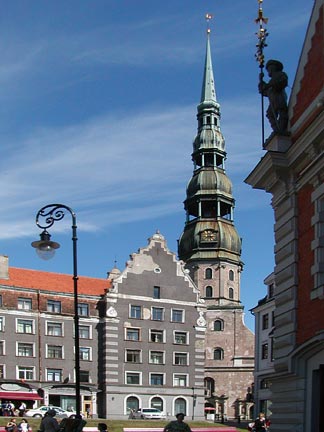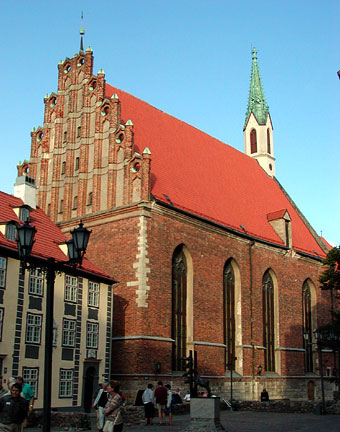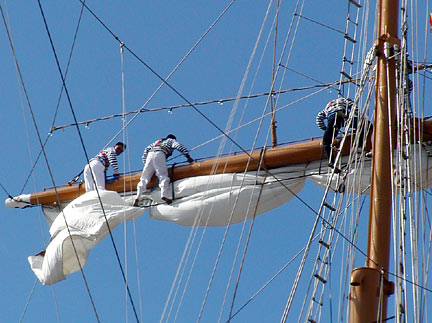 |
||||||||||||||||||||||||||||
|
We visited Latvia in August, 2003. Latvia is 64,589 square kilometers (40,133 square miles) and wider east to west than Estonia to the north or Lithuania to the south. Rīga, the capital, is a major seaport situated on the Gulf of Rīga which covers half of the coast line the country has along the Baltic Sea. Also bordering Latvia are Russia and Belarus to the east. Of the 2.33 million people in Latvia, 58.3% are ethnically Latvian. More than 29% of the population is Russian. In June 1993 Latvia held its first post independence elections. The last Soviet troops withdrew from Latvia in 1994.
The old town area is now mostly pedestrianized, although you can drive through if you pay by the hour (motorcycles are exempt from the charge). This system keeps most of the vehicles off the streets and makes for a peasant experience as you wander through the twisting streets. One of the more dominant sights in the city is the spire of the St. Peters church (built in 1209, photo below left). The steeple of the gothic church has been built 3 times in the same baroque style - originally in wood in the 1660s, again in wood in the 18 century after it burnt down from a lightening strike, and again from 1967-73, (this time in steel) after it was burned in W.W.II.
Along side the Guild Hall is a large copper-clad modern structure built by the Soviets. This now houses the Occupation Museum, the story of Latvia under Russian rule. It is not a pretty story, but it is a valuable one, relating the injustice of occupying forces as well as the determination of a people yearning to be free. Many stories are included about the Siberian gulags, the deportations, and the general living conditions under Russian rule. A typical family shared an apartment with several other families, each family living in a bedroom and all of them sharing the kitchen and bath. After all, according to the Russians, each person only needed 9 square meters (about 28 sq ft) of living space!
Near the top of the wall (about even with the top of the windows) are 2 stone faces, supposedly the faces of 2 monks who were buried alive in the walls (shown at right, above & below). The legend has it that in 1454 the monks chose to sacrifice themselves in this manner so the city would be stable and successful. They Unfortunately, the post was a bit slow in those days and the reply came back only after the monks had been sacrificed. As the Pope was not in agreement with the activity, it was all hushed up and quietly forgotten until the bodies were discovered in the 19th century during renovations. The house to the left of the church in the photo above was built in the 16th century and was the first “hotel” in Riga. Later in the same century it was used as a home for widows of craftsmen As Rīga was a merchants town, several Guild Halls were built. The one below, left is the Great Guild Hall, built for wealthy German merchants in the 19th century. In the foreground of the photo there are blue-flowering plants in waves across the grass - this is to symbolize that this was the route of the river when old Riga was built. The wave pattern also continues onto the stone pathway through the plaza.
Across the street from the Guild Hall is the Cat House, a house built by a Latvian merchant in the 20th century whose was barred from joining the guild (because it was for Germans). Upset at this shame, he had 2 black cats mounted on the roof of his house, both facing the Guild Hall as a measure of protest. Later, after a lengthy court case, he was granted admission to the guild on the condition that he turn the cats around to a more elegant position (i.e., not pointing at the Guild Hall). They still grace the house today and they no longer point to the Guild House.
This statue replaced an earlier statue of Peter the Great. During the Russian rule after the war, this statue was off-limits (although thankfully it wasn’t taken down) and a statue fo Lenin, facing the other way was placed 2 blocks away. The Lenin statue was removed on the night of August 20, 1991 after the collapse of the Moscow coup attempt. Riga is also known for its unique Art Nouveau architectural style, Jugendstil. In the outer avenues, many houses built around the turn of the century are excellent examples of this unusual style.
We happened to time our visit to Riga to coincide with the arrival of the Tall Ships (actually, it was totally by accident, but a fortunate one).
When we first arrived at the scene, the wind was blowing fiercely and one of the sails on Mexico’s ship was coming loose, so several sailors were sent up to set it right (above, right). Given the height, rigging and wind, we were very glad it was them and not us up there! Of course, this was probably much easier in port with the ship quite still, rather than having to perform this maneuver while at sea with the ship pitching and rolling about.
On our way out of Riga, heading north to Tallinn, we made a slight detour through the small town of Sigulda. We headed here because it is on the edge of the Guaja National Park and because it is a winter sport area with an Olympic bobsled run. We had read that during the summers visitors can ride small wheeled vehicles down the bobsled run and we though this would be run to do. Unfortunately, they only run on Saturdays and we were not there on a Saturday. But the ride was not in vain as the surrounding area is beautiful. We passed back through Latvia on our way south from Estonia, but made no other sightseeing stops. However, we did stop one afternoon for gas in a small village in southeast Latvia. Here, the young man in the office spoke English and was quite interested in where we were from, as they don’t get many foreign visitors here. When Verna told him California, his jaw literally fell open. He couldn’t believe it, especially that we had brought the bikes with us. Then, as we were about to leave, another local came in, very interested in the bikes, but spoke no English. As we were pulling away, he came running out of the shop, yelling and trying to hand Verna a soda he bought for us. We think the young man inside told him where we were from and this was his way of saying welcome. We didn’t take the soda as we had no place to put it, but we were very pleased by the thought. |
||||||||||||||||||||||||||||
|
If you find typographical errors or have any other problems when looking at the site please contact the Webmaster describing the problem and the page involved. |
||||||||||||||||||||||||||||
|
Copyright © 2000-2009 Jim Seavey and Verna Norris All Rights Reserved |
||||||||||||||||||||||||||||



 Another nearby church is St. John’s church, originally built in the 13th century for Bi
Another nearby church is St. John’s church, originally built in the 13th century for Bi shop Albert and later given to the monks. It is now an amalgamation of gothic, renaissance and baroque styles as subsequent building has occurred through the centuries.
shop Albert and later given to the monks. It is now an amalgamation of gothic, renaissance and baroque styles as subsequent building has occurred through the centuries.  even wrote to the Pope, asking his permission. The Pope replied that this was not appropriate and should not occur.
even wrote to the Pope, asking his permission. The Pope replied that this was not appropriate and should not occur. 







 While strolling through town, we found a lot of musicians playing for the odd coin or two. What we didn’t expect was the quality of music we heard. Every one of them was quite accomplished, even the younger ones like the 2 pictured at left. We can only hope that they are not the family’s sole means of support.
While strolling through town, we found a lot of musicians playing for the odd coin or two. What we didn’t expect was the quality of music we heard. Every one of them was quite accomplished, even the younger ones like the 2 pictured at left. We can only hope that they are not the family’s sole means of support.